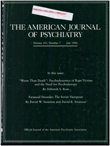Overview: a current perspective on twin studies of schizophrenia
Abstract
The author reviews the results of twin studies of schizophrenia from the perspective of recent advances in our understanding of the twin method and of the transmission of schizophrenia. The evidence suggests that twin studies of schizophrenia are not likely to be substantially biased by the greater similarity in social environment of identical versus fraternal twins. Raw concordance figures from twin studies of schizophrenia are quite variable. When models to estimate the etiologic importance of genetic factors are applied to these figures, the results from all studies are similar. According to these models, genetic factors are as etiologically important in schizophrenia as in such medical conditions as diabetes and hypertension. Twin studies of schizophrenia probably provide a valid measure of the major etiologic role genetic factors play in schizophrenia.
Access content
To read the fulltext, please use one of the options below to sign in or purchase access.- Personal login
- Institutional Login
- Sign in via OpenAthens
- Register for access
-
Please login/register if you wish to pair your device and check access availability.
Not a subscriber?
PsychiatryOnline subscription options offer access to the DSM-5 library, books, journals, CME, and patient resources. This all-in-one virtual library provides psychiatrists and mental health professionals with key resources for diagnosis, treatment, research, and professional development.
Need more help? PsychiatryOnline Customer Service may be reached by emailing [email protected] or by calling 800-368-5777 (in the U.S.) or 703-907-7322 (outside the U.S.).



